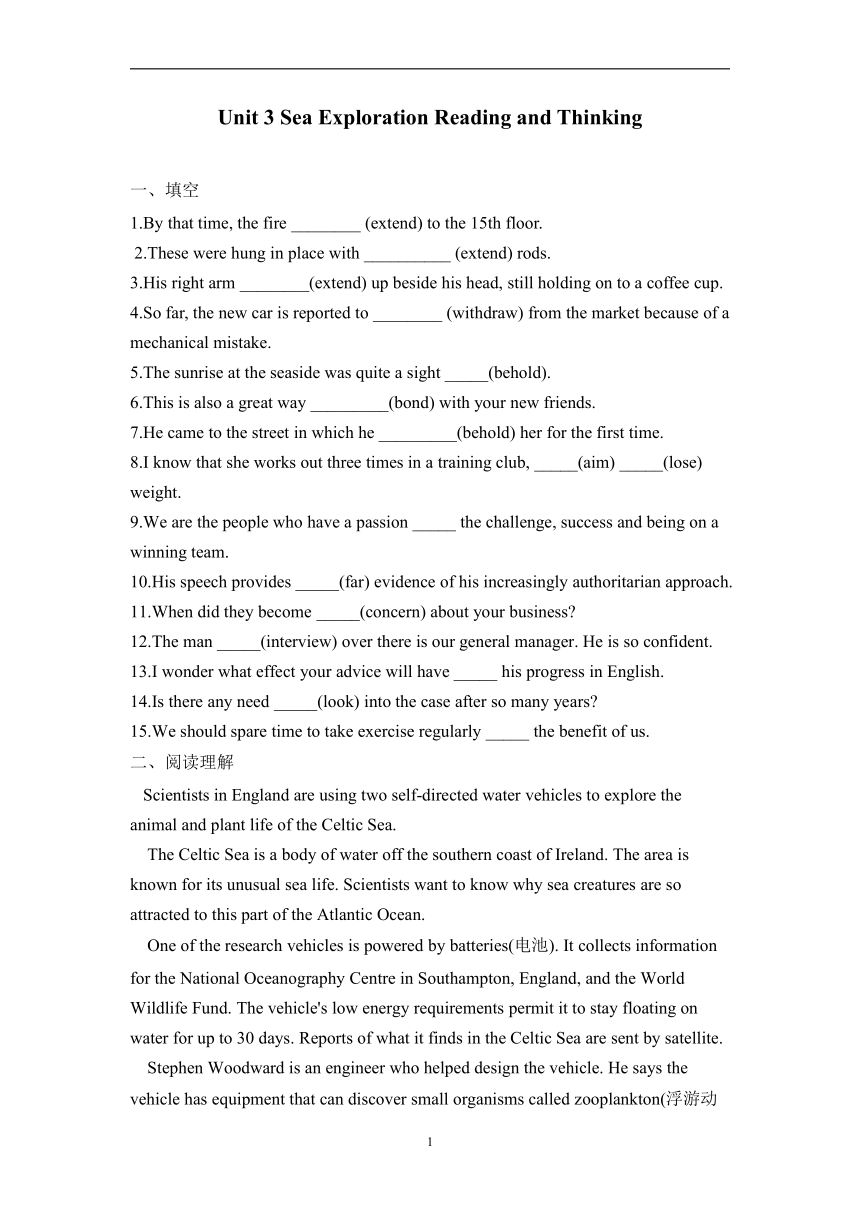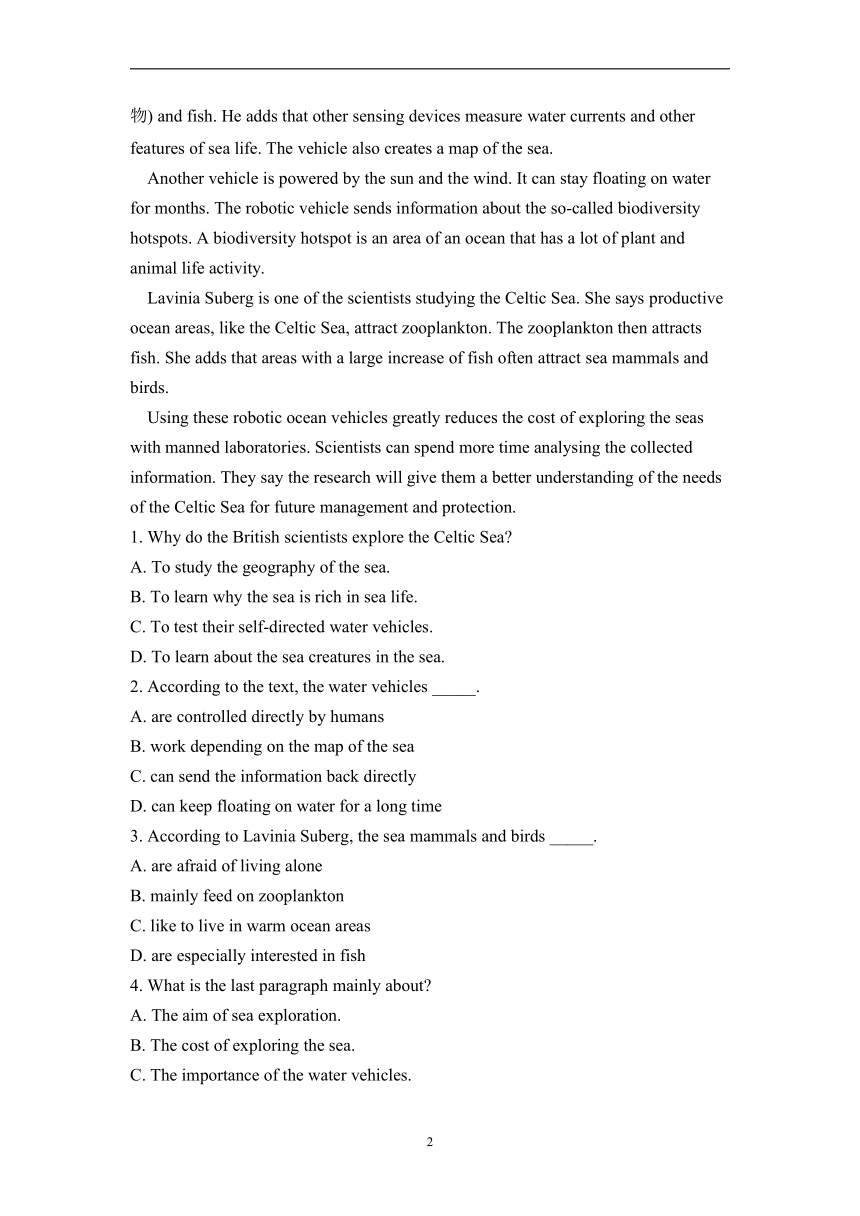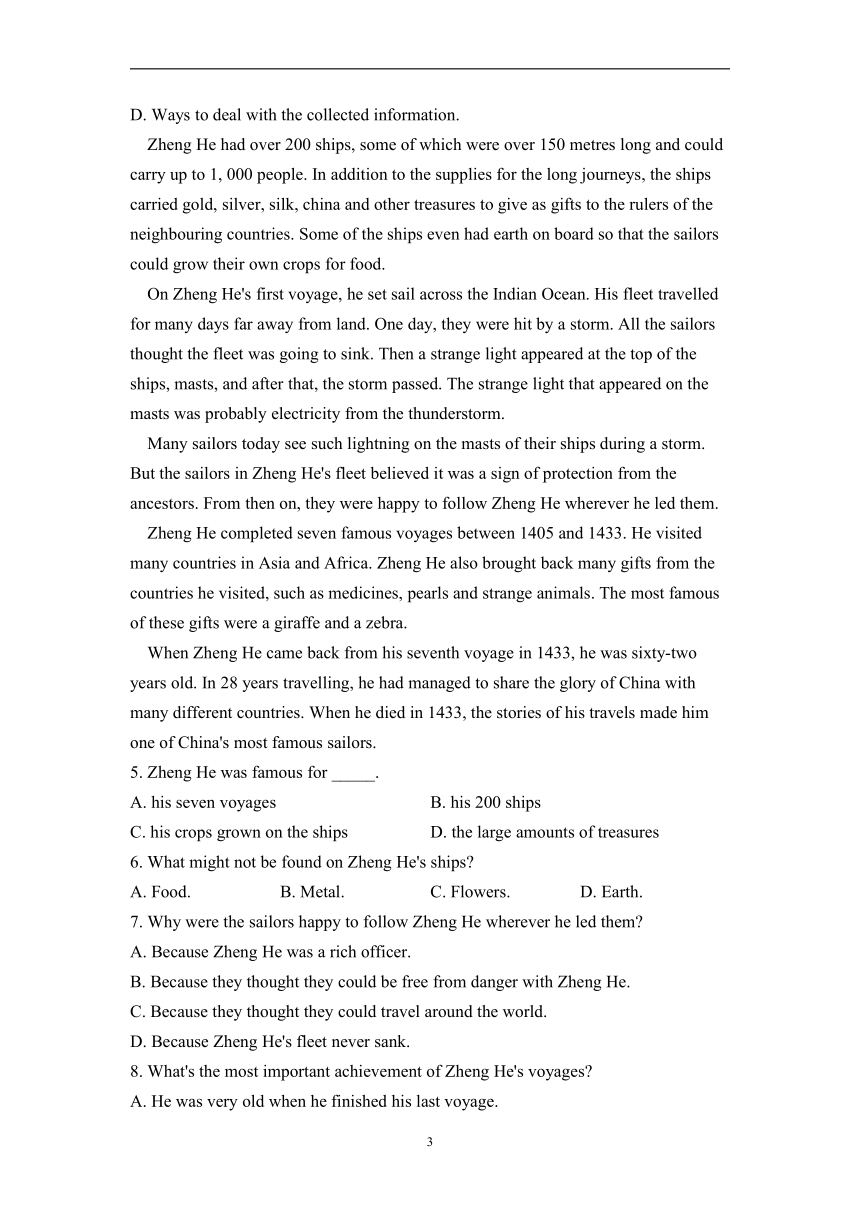人教版(2019)选择性必修第四册Unit 3 Sea Exploration Reading and Thinking课时练习(有答案)
文档属性
| 名称 | 人教版(2019)选择性必修第四册Unit 3 Sea Exploration Reading and Thinking课时练习(有答案) |  | |
| 格式 | docx | ||
| 文件大小 | 23.3KB | ||
| 资源类型 | 教案 | ||
| 版本资源 | 人教版(2019) | ||
| 科目 | 英语 | ||
| 更新时间 | 2023-03-07 12:21:04 | ||
图片预览



文档简介
Unit 3 Sea Exploration Reading and Thinking
一、填空
1.By that time, the fire ________ (extend) to the 15th floor.
2.These were hung in place with __________ (extend) rods.
3.His right arm ________(extend) up beside his head, still holding on to a coffee cup.
4.So far, the new car is reported to ________ (withdraw) from the market because of a mechanical mistake.
5.The sunrise at the seaside was quite a sight _____(behold).
6.This is also a great way _________(bond) with your new friends.
7.He came to the street in which he _________(behold) her for the first time.
8.I know that she works out three times in a training club, _____(aim) _____(lose) weight.
9.We are the people who have a passion _____ the challenge, success and being on a winning team.
10.His speech provides _____(far) evidence of his increasingly authoritarian approach.
11.When did they become _____(concern) about your business
12.The man _____(interview) over there is our general manager. He is so confident.
13.I wonder what effect your advice will have _____ his progress in English.
14.Is there any need _____(look) into the case after so many years
15.We should spare time to take exercise regularly _____ the benefit of us.
二、阅读理解
Scientists in England are using two self-directed water vehicles to explore the animal and plant life of the Celtic Sea.
The Celtic Sea is a body of water off the southern coast of Ireland. The area is known for its unusual sea life. Scientists want to know why sea creatures are so attracted to this part of the Atlantic Ocean.
One of the research vehicles is powered by batteries(电池). It collects information for the National Oceanography Centre in Southampton, England, and the World Wildlife Fund. The vehicle's low energy requirements permit it to stay floating on water for up to 30 days. Reports of what it finds in the Celtic Sea are sent by satellite.
Stephen Woodward is an engineer who helped design the vehicle. He says the vehicle has equipment that can discover small organisms called zooplankton(浮游动物) and fish. He adds that other sensing devices measure water currents and other features of sea life. The vehicle also creates a map of the sea.
Another vehicle is powered by the sun and the wind. It can stay floating on water for months. The robotic vehicle sends information about the so-called biodiversity hotspots. A biodiversity hotspot is an area of an ocean that has a lot of plant and animal life activity.
Lavinia Suberg is one of the scientists studying the Celtic Sea. She says productive ocean areas, like the Celtic Sea, attract zooplankton. The zooplankton then attracts fish. She adds that areas with a large increase of fish often attract sea mammals and birds.
Using these robotic ocean vehicles greatly reduces the cost of exploring the seas with manned laboratories. Scientists can spend more time analysing the collected information. They say the research will give them a better understanding of the needs of the Celtic Sea for future management and protection.
1. Why do the British scientists explore the Celtic Sea
A. To study the geography of the sea.
B. To learn why the sea is rich in sea life.
C. To test their self-directed water vehicles.
D. To learn about the sea creatures in the sea.
2. According to the text, the water vehicles _____.
A. are controlled directly by humans
B. work depending on the map of the sea
C. can send the information back directly
D. can keep floating on water for a long time
3. According to Lavinia Suberg, the sea mammals and birds _____.
A. are afraid of living alone
B. mainly feed on zooplankton
C. like to live in warm ocean areas
D. are especially interested in fish
4. What is the last paragraph mainly about
A. The aim of sea exploration.
B. The cost of exploring the sea.
C. The importance of the water vehicles.
D. Ways to deal with the collected information.
Zheng He had over 200 ships, some of which were over 150 metres long and could carry up to 1, 000 people. In addition to the supplies for the long journeys, the ships carried gold, silver, silk, china and other treasures to give as gifts to the rulers of the neighbouring countries. Some of the ships even had earth on board so that the sailors could grow their own crops for food.
On Zheng He's first voyage, he set sail across the Indian Ocean. His fleet travelled for many days far away from land. One day, they were hit by a storm. All the sailors thought the fleet was going to sink. Then a strange light appeared at the top of the ships, masts, and after that, the storm passed. The strange light that appeared on the masts was probably electricity from the thunderstorm.
Many sailors today see such lightning on the masts of their ships during a storm. But the sailors in Zheng He's fleet believed it was a sign of protection from the ancestors. From then on, they were happy to follow Zheng He wherever he led them.
Zheng He completed seven famous voyages between 1405 and 1433. He visited many countries in Asia and Africa. Zheng He also brought back many gifts from the countries he visited, such as medicines, pearls and strange animals. The most famous of these gifts were a giraffe and a zebra.
When Zheng He came back from his seventh voyage in 1433, he was sixty-two years old. In 28 years travelling, he had managed to share the glory of China with many different countries. When he died in 1433, the stories of his travels made him one of China's most famous sailors.
5. Zheng He was famous for _____.
A. his seven voyages B. his 200 ships
C. his crops grown on the ships D. the large amounts of treasures
6. What might not be found on Zheng He's ships
A. Food. B. Metal. C. Flowers. D. Earth.
7. Why were the sailors happy to follow Zheng He wherever he led them
A. Because Zheng He was a rich officer.
B. Because they thought they could be free from danger with Zheng He.
C. Because they thought they could travel around the world.
D. Because Zheng He's fleet never sank.
8. What's the most important achievement of Zheng He's voyages
A. He was very old when he finished his last voyage.
B. He set sail across the Indian Ocean.
C. He brought back many gifts from the countries he visited.
D. He promoted the communication between China and other countries.
答案以及解析
一、填空
1.答案: had extended
解析:考查时态,句意:到这时,火势已蔓延至l5楼,根据上文By this time并结合句意可知,extend表示“过去的过去”发生的动作,用过去完成时。故填had extended。
2.答案:extendable
3.答案:was extended
解析:考查语态和时态,句意:他的右臂向头的一侧伸开,手上还紧紧握着一只咖啡杯。主语arm与extend之间是被动关系,应用被动态;题目讲述的是过去发生的事,应用一般过去式;主语单数,谓语单数形式,故填was extended。
4.答案:have been withdrawn
5.答案:to behold
6.答案:to bond
解析:考查非谓语动词。句意:这也是和你的新朋友增强信任关系的一个好方法。分析可知,此处是不定式作后置定语,故填 to bond。
7.答案:had beheld
解析:考查时态。句意:他来到了他头一次看见她的那条大街。分析可知 behold 动作发生在 came 之前,故应用过去完成时。
8.答案:aiming, to lose
9.答案:for
10.答案:further
11.答案:concerned
12.答案:being interviewed
13.答案:on
14.答案:to look
15.答案:for
解析:考查介词。for the benefit of…是固定短语,表示“为……的利益;为帮助……”。
二、阅读理解
答案:1-4 BDDC
解析:1.推理判断题。由第二段中的“Scientists want to know why sea creatures are so attracted to this part of the Atlantic Ocean.”可知,研究旨在弄清楚为什么凯尔特海富含海洋生物。
2.细节理解题。由第三段中的“The vehicle's low energy requirements permit it to stay floating on water for up to 30 days.”和第五段中的“It can stay floating on water for months.”可知,它们都能在海中漂浮很久。
3.细节理解题。由倒数第二段中的“She adds that areas with a large increase of fish often attract sea mammals and birds.”可知,它们对鱼很感兴趣。
4.段落大意题。由最后一段中的“greatly reduces”, “spend more time…”和“a better understanding”可知,本段旨在介绍这两个水中机器人在海底探索中的重要性。
答案:5-8 ACBD
解析:5.细节理解题。根据短文最后两段的信息可知,郑和出名是因为他七下西洋,故选A项。
6.细节理解题。根据短文第一段提供的信息可知,郑和的船上可能没有花朵,故C项正确。
7.细节理解题。根据短文第三段的信息“the sailors in Zheng He's fleet believed it was a sign of protection from the ancestors. From then on, they were happy to follow Zheng He wherever he led them”可知,本题应选B项。
8.推理判断题。理解文章可知,郑和七下西洋对于促进中国和其他国家的交流起到了极大的作用,故本题D项合理。
2
一、填空
1.By that time, the fire ________ (extend) to the 15th floor.
2.These were hung in place with __________ (extend) rods.
3.His right arm ________(extend) up beside his head, still holding on to a coffee cup.
4.So far, the new car is reported to ________ (withdraw) from the market because of a mechanical mistake.
5.The sunrise at the seaside was quite a sight _____(behold).
6.This is also a great way _________(bond) with your new friends.
7.He came to the street in which he _________(behold) her for the first time.
8.I know that she works out three times in a training club, _____(aim) _____(lose) weight.
9.We are the people who have a passion _____ the challenge, success and being on a winning team.
10.His speech provides _____(far) evidence of his increasingly authoritarian approach.
11.When did they become _____(concern) about your business
12.The man _____(interview) over there is our general manager. He is so confident.
13.I wonder what effect your advice will have _____ his progress in English.
14.Is there any need _____(look) into the case after so many years
15.We should spare time to take exercise regularly _____ the benefit of us.
二、阅读理解
Scientists in England are using two self-directed water vehicles to explore the animal and plant life of the Celtic Sea.
The Celtic Sea is a body of water off the southern coast of Ireland. The area is known for its unusual sea life. Scientists want to know why sea creatures are so attracted to this part of the Atlantic Ocean.
One of the research vehicles is powered by batteries(电池). It collects information for the National Oceanography Centre in Southampton, England, and the World Wildlife Fund. The vehicle's low energy requirements permit it to stay floating on water for up to 30 days. Reports of what it finds in the Celtic Sea are sent by satellite.
Stephen Woodward is an engineer who helped design the vehicle. He says the vehicle has equipment that can discover small organisms called zooplankton(浮游动物) and fish. He adds that other sensing devices measure water currents and other features of sea life. The vehicle also creates a map of the sea.
Another vehicle is powered by the sun and the wind. It can stay floating on water for months. The robotic vehicle sends information about the so-called biodiversity hotspots. A biodiversity hotspot is an area of an ocean that has a lot of plant and animal life activity.
Lavinia Suberg is one of the scientists studying the Celtic Sea. She says productive ocean areas, like the Celtic Sea, attract zooplankton. The zooplankton then attracts fish. She adds that areas with a large increase of fish often attract sea mammals and birds.
Using these robotic ocean vehicles greatly reduces the cost of exploring the seas with manned laboratories. Scientists can spend more time analysing the collected information. They say the research will give them a better understanding of the needs of the Celtic Sea for future management and protection.
1. Why do the British scientists explore the Celtic Sea
A. To study the geography of the sea.
B. To learn why the sea is rich in sea life.
C. To test their self-directed water vehicles.
D. To learn about the sea creatures in the sea.
2. According to the text, the water vehicles _____.
A. are controlled directly by humans
B. work depending on the map of the sea
C. can send the information back directly
D. can keep floating on water for a long time
3. According to Lavinia Suberg, the sea mammals and birds _____.
A. are afraid of living alone
B. mainly feed on zooplankton
C. like to live in warm ocean areas
D. are especially interested in fish
4. What is the last paragraph mainly about
A. The aim of sea exploration.
B. The cost of exploring the sea.
C. The importance of the water vehicles.
D. Ways to deal with the collected information.
Zheng He had over 200 ships, some of which were over 150 metres long and could carry up to 1, 000 people. In addition to the supplies for the long journeys, the ships carried gold, silver, silk, china and other treasures to give as gifts to the rulers of the neighbouring countries. Some of the ships even had earth on board so that the sailors could grow their own crops for food.
On Zheng He's first voyage, he set sail across the Indian Ocean. His fleet travelled for many days far away from land. One day, they were hit by a storm. All the sailors thought the fleet was going to sink. Then a strange light appeared at the top of the ships, masts, and after that, the storm passed. The strange light that appeared on the masts was probably electricity from the thunderstorm.
Many sailors today see such lightning on the masts of their ships during a storm. But the sailors in Zheng He's fleet believed it was a sign of protection from the ancestors. From then on, they were happy to follow Zheng He wherever he led them.
Zheng He completed seven famous voyages between 1405 and 1433. He visited many countries in Asia and Africa. Zheng He also brought back many gifts from the countries he visited, such as medicines, pearls and strange animals. The most famous of these gifts were a giraffe and a zebra.
When Zheng He came back from his seventh voyage in 1433, he was sixty-two years old. In 28 years travelling, he had managed to share the glory of China with many different countries. When he died in 1433, the stories of his travels made him one of China's most famous sailors.
5. Zheng He was famous for _____.
A. his seven voyages B. his 200 ships
C. his crops grown on the ships D. the large amounts of treasures
6. What might not be found on Zheng He's ships
A. Food. B. Metal. C. Flowers. D. Earth.
7. Why were the sailors happy to follow Zheng He wherever he led them
A. Because Zheng He was a rich officer.
B. Because they thought they could be free from danger with Zheng He.
C. Because they thought they could travel around the world.
D. Because Zheng He's fleet never sank.
8. What's the most important achievement of Zheng He's voyages
A. He was very old when he finished his last voyage.
B. He set sail across the Indian Ocean.
C. He brought back many gifts from the countries he visited.
D. He promoted the communication between China and other countries.
答案以及解析
一、填空
1.答案: had extended
解析:考查时态,句意:到这时,火势已蔓延至l5楼,根据上文By this time并结合句意可知,extend表示“过去的过去”发生的动作,用过去完成时。故填had extended。
2.答案:extendable
3.答案:was extended
解析:考查语态和时态,句意:他的右臂向头的一侧伸开,手上还紧紧握着一只咖啡杯。主语arm与extend之间是被动关系,应用被动态;题目讲述的是过去发生的事,应用一般过去式;主语单数,谓语单数形式,故填was extended。
4.答案:have been withdrawn
5.答案:to behold
6.答案:to bond
解析:考查非谓语动词。句意:这也是和你的新朋友增强信任关系的一个好方法。分析可知,此处是不定式作后置定语,故填 to bond。
7.答案:had beheld
解析:考查时态。句意:他来到了他头一次看见她的那条大街。分析可知 behold 动作发生在 came 之前,故应用过去完成时。
8.答案:aiming, to lose
9.答案:for
10.答案:further
11.答案:concerned
12.答案:being interviewed
13.答案:on
14.答案:to look
15.答案:for
解析:考查介词。for the benefit of…是固定短语,表示“为……的利益;为帮助……”。
二、阅读理解
答案:1-4 BDDC
解析:1.推理判断题。由第二段中的“Scientists want to know why sea creatures are so attracted to this part of the Atlantic Ocean.”可知,研究旨在弄清楚为什么凯尔特海富含海洋生物。
2.细节理解题。由第三段中的“The vehicle's low energy requirements permit it to stay floating on water for up to 30 days.”和第五段中的“It can stay floating on water for months.”可知,它们都能在海中漂浮很久。
3.细节理解题。由倒数第二段中的“She adds that areas with a large increase of fish often attract sea mammals and birds.”可知,它们对鱼很感兴趣。
4.段落大意题。由最后一段中的“greatly reduces”, “spend more time…”和“a better understanding”可知,本段旨在介绍这两个水中机器人在海底探索中的重要性。
答案:5-8 ACBD
解析:5.细节理解题。根据短文最后两段的信息可知,郑和出名是因为他七下西洋,故选A项。
6.细节理解题。根据短文第一段提供的信息可知,郑和的船上可能没有花朵,故C项正确。
7.细节理解题。根据短文第三段的信息“the sailors in Zheng He's fleet believed it was a sign of protection from the ancestors. From then on, they were happy to follow Zheng He wherever he led them”可知,本题应选B项。
8.推理判断题。理解文章可知,郑和七下西洋对于促进中国和其他国家的交流起到了极大的作用,故本题D项合理。
2
